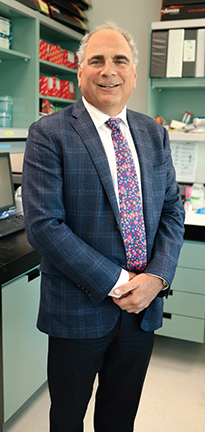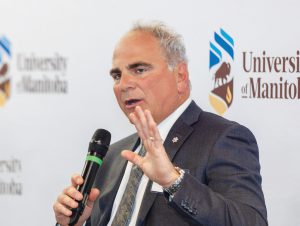
When Lorrie Kirshenbaum [B.Sc./86, M.Sc./88, PhD/92] was growing up in Winnipeg’s North End, his immigrant father owned a TV and electronics store.
“As a kid, I was always very inquisitive about how things worked,” the professor of physiology and pathophysiology recalls. “I would take things apart and put them back together.”
That curiosity and drive to understand inner workings propelled Kirshenbaum to a research career focused on the mechanisms of heart disease.
The three-time UM alum was recently honoured by the university with the 2023 Dr. John M. Bowman Memorial Winnipeg Rh Institute Foundation Award in recognition of his outstanding research accomplishments.
In his acceptance speech, the scientist paid tribute to his mother and his late father as positive role models. Early in Kirshenbaum’s career, his dad would often call the lab.
“He would say, ‘So, kid, what have you discovered today?’ More often than not, I’d tell him [my experiments] didn’t work. But he was always very encouraging. He’d say, ‘Tomorrow is another day.’”
Kirshenbaum persevered and kept innovating in his approach to heart disease. “You have an idea, and you chase it down,” he says.
Now a faculty member for nearly 30 years, he holds a UM Canada Research Chair in molecular cardiology and is director of the Institute of Cardiovascular Sciences at the St. Boniface Hospital Albrechtsen Research Centre.
A global leader in the field of cardiac cell death, he has brought medical science closer to the goal of reversing or preventing heart failure.
His many awards include several honours from the International Academy of Cardiovascular Sciences, the Research Achievement Award from the Canadian Cardiovascular Society and the Order of Manitoba.

While Kirshenbaum could have left Manitoba for a larger centre, he says he values the exceptional training and mentorship he received in UM labs, as well as the support UM has given to his research.
“I’m a proud UM alumnus,” he says. “I’ve had the unique opportunity here to develop a research program on cardiac cell death that has become internationally recognized and a training program that has inspired a whole new generation.”
Each breakthrough Kirshenbaum has made has raised further questions, leading him into new areas of study. He has progressed from being tightly focused on the molecular processes of heart disease to leading a new, comprehensive Manitoba research program to support women’s heart health.
He recently spoke about some of his research highlights.
Early in your career, you changed scientists’ understanding of how heart muscle is damaged during heart attacks. What did you discover?
When a person has a heart attack, cardiac muscle cells die. You’re left with scar tissue that doesn’t contract well, and ultimately this will lead to heart failure – the inability of the heart to pump well enough for the body’s needs.
One of my lab’s pioneering discoveries was that the mode of cell death from a heart attack is not random. It’s triggered by certain genes that are switched on inside the cells. This discovery has allowed us to develop prototype drugs to switch off the genes and prevent heart muscle damage at a cellular level.
Our work also revealed that similar genetic processes cause both heart disease and cancer. In heart disease, excessive cell death leads to heart failure. In cancer, tumours result when there is not enough cell death. The same mechanism that is activated in heart disease could one day lead us to a genetic treatment for cancer.
What can you tell us about the body clock and cardiac dysfunction?
Our body’s circadian clock genes are programmed for 12 hours of light and 12 hours of darkness. This 24-hour cycle regulates many physiological processes and prepares the body for the stress of the day. That’s why disrupting the body clock with things like shift work and jet lag is damaging to heart health.
We created a mouse model of circadian disruption to investigate why shift workers have a greater than 40 per cent higher risk of heart attack than non-shift workers.
We discovered that in these mice, autophagy – the normal recycling process inside cells – was impaired. Cellular debris accumulated, reducing cardiac function. We found that by reactivating autophagy, we could circumvent the effects of body-clock disruption. This points to restoring autophagy as a way to reduce heart muscle damage.
What about your research on heart failure as a side effect of cancer drugs?
When cancer patients are treated, whether it’s with chemotherapy, radiation or immune checkpoint inhibitors, the heart muscle becomes damaged. It can happen right away, or it can manifest many years later.
Doxorubicin, in particular, is an effective chemotherapy drug, but has this nasty effect on the heart. We’re now looking at whether body clock disruption in cancer patients, and the resulting impaired autophagy, plays a role in the harmful effects of doxorubicin on the heart.
Doxorubicin is particularly used in treating women’s cancers, and that’s part of what led me to spearhead a women’s heart health program.
Why was it important to establish the women’s program?
Women’s heart disease is under-studied, under-diagnosed, under-treated and under-supported. Women are at greater risk for developing more debilitating forms of heart disease than men.
Some of the risk factors for women’s heart disease that we’re just starting to understand are preterm delivery, hypertensive disorders of pregnancy, gestational diabetes, autoimmune disease, cancer treatment (as I mentioned) and mental illness.
This year we received $3.9 million in federal and provincial funding to develop lab infrastructure for our new Women’s Heart Health research program at St. Boniface Hospital, with UM as another funding partner.
We’ve also established partnerships with other centres, including the Barbra Streisand Women’s Heart Center at Cedars-Sinai Medical Center in Los Angeles. This will give the Institute of Cardiovascular Sciences and UM tremendous reach for extending our global presence and building our research capacity.
BY ALISON MAYES
With files from Davide Montebruno
